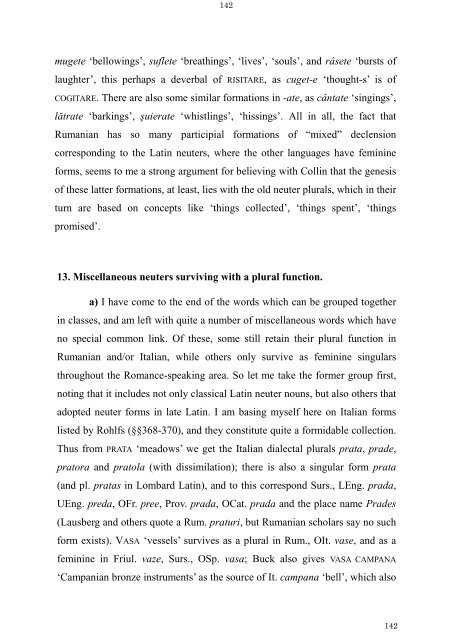The Latin Neuter Plurals in Romance - Page ON
The Latin Neuter Plurals in Romance - Page ON
The Latin Neuter Plurals in Romance - Page ON
Create successful ePaper yourself
Turn your PDF publications into a flip-book with our unique Google optimized e-Paper software.
142<br />
mugete ‘bellow<strong>in</strong>gs’, suflete ‘breath<strong>in</strong>gs’, ‘lives’, ‘souls’, and râsete ‘bursts of<br />
laughter’, this perhaps a deverbal of RISITARE, as cuget-e ‘thought-s’ is of<br />
COGITARE. <strong>The</strong>re are also some similar formations <strong>in</strong> -ate, as cântate ‘s<strong>in</strong>g<strong>in</strong>gs’,<br />
lătrate ‘bark<strong>in</strong>gs’, şuierate ‘whistl<strong>in</strong>gs’, ‘hiss<strong>in</strong>gs’. All <strong>in</strong> all, the fact that<br />
Rumanian has so many participial formations of “mixed” declension<br />
correspond<strong>in</strong>g to the <strong>Lat<strong>in</strong></strong> neuters, where the other languages have fem<strong>in</strong><strong>in</strong>e<br />
forms, seems to me a strong argument for believ<strong>in</strong>g with Coll<strong>in</strong> that the genesis<br />
of these latter formations, at least, lies with the old neuter plurals, which <strong>in</strong> their<br />
turn are based on concepts like ‘th<strong>in</strong>gs collected’, ‘th<strong>in</strong>gs spent’, ‘th<strong>in</strong>gs<br />
promised’.<br />
13. Miscellaneous neuters surviv<strong>in</strong>g with a plural function.<br />
a) I have come to the end of the words which can be grouped together<br />
<strong>in</strong> classes, and am left with quite a number of miscellaneous words which have<br />
no special common l<strong>in</strong>k. Of these, some still reta<strong>in</strong> their plural function <strong>in</strong><br />
Rumanian and/or Italian, while others only survive as fem<strong>in</strong><strong>in</strong>e s<strong>in</strong>gulars<br />
throughout the <strong>Romance</strong>-speak<strong>in</strong>g area. So let me take the former group first,<br />
not<strong>in</strong>g that it <strong>in</strong>cludes not only classical <strong>Lat<strong>in</strong></strong> neuter nouns, but also others that<br />
adopted neuter forms <strong>in</strong> late <strong>Lat<strong>in</strong></strong>. I am bas<strong>in</strong>g myself here on Italian forms<br />
listed by Rohlfs (§§368-370), and they constitute quite a formidable collection.<br />
Thus from PRATA ‘meadows’ we get the Italian dialectal plurals prata, prade,<br />
pratora and pratola (with dissimilation); there is also a s<strong>in</strong>gular form prata<br />
(and pl. pratas <strong>in</strong> Lombard <strong>Lat<strong>in</strong></strong>), and to this correspond Surs., LEng. prada,<br />
UEng. preda, OFr. pree, Prov. prada, OCat. prada and the place name Prades<br />
(Lausberg and others quote a Rum. praturi, but Rumanian scholars say no such<br />
form exists). VASA ‘vessels’ survives as a plural <strong>in</strong> Rum., OIt. vase, and as a<br />
fem<strong>in</strong><strong>in</strong>e <strong>in</strong> Friul. vaze, Surs., OSp. vasa; Buck also gives VASA CAMPANA<br />
‘Campanian bronze <strong>in</strong>struments’ as the source of It. campana ‘bell’, which also<br />
142









